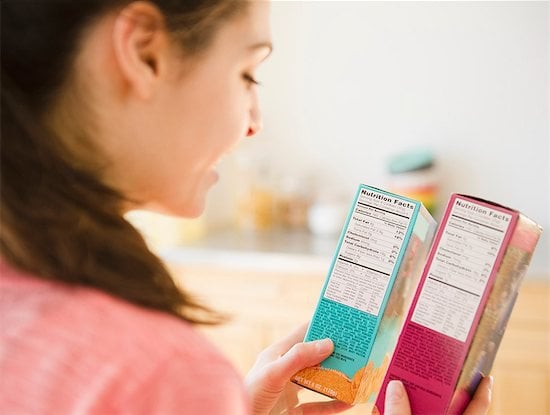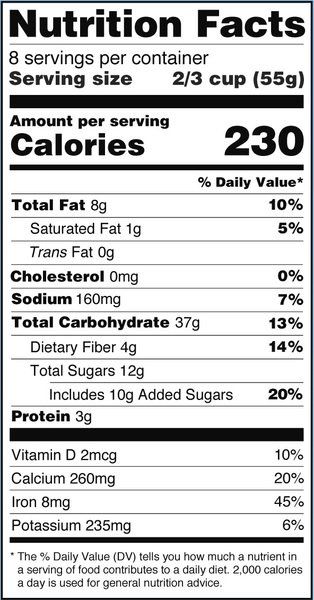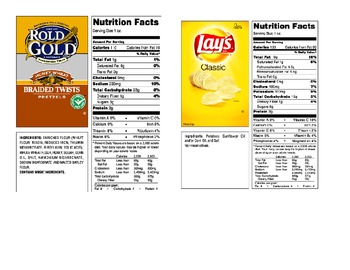41 nutritional value on food labels
Food Label Accuracy of Common Snack Foods - PMC As specified by the Code of Federal Regulations ( 10 ), calories on food labels represent metabolizable energy, i.e. total (gross) calories minus calories that are excreted in stool and urine. However, doubts regarding the accuracy of energy content labeling of packaged foods have been expressed. Nutrition Labels Decoded: Tips For Choosing Food Wisely ... What's On A Nutrition Label? You're probably familiar with what a nutrition facts label looks like on a packaged food item. These labels have been required to be on all packaged and processed foods for many decades, and list things like the ingredients and the nutritional information such as calories, fat, and carbohydrates.
Food Labels - Nutrition.gov The U.S. Food and Drug Administration (FDA) has updated the Nutrition Facts label on packaged foods and beverages with a fresh design that will make it easier for you to make informed food choices that contribute to lifelong healthy eating habits. What's in a Name? What Every Consumer Should Know About Foods and Flavors

Nutritional value on food labels
Food Labels | CDC If you eat the whole thing, you are eating 8 times the amount of calories, carbs, fat, etc., shown on the label. Total Carbohydrate shows you types of carbs in the food, including sugar and fiber. Choose foods with more fiber, vitamins, and minerals. Choose foods with lower calories, saturated fat, sodium, and added sugars. Avoid trans fat. Food labels - NHS Nutrition labels are often displayed as a panel or grid on the back or side of packaging. This type of label includes information on energy (kJ/kcal), fat, saturates (saturated fat), carbohydrate, sugars, protein and salt. It may also provide additional information on certain nutrients, such as fibre. Understanding Ingredients on Food Labels | American Heart ... The American Heart Association recommends no more than 1,500 milligrams of sodium a day, but the average American consumes twice that much. Perhaps trickiest of all is trans fats. You won't find these listed as trans fats at all, but rather ingredients that contain trans fats: mainly partially hydrogenated oil and hydrogenated oil.
Nutritional value on food labels. Food Labels 101: Understanding the Nutrition Facts Label ... A sodium level of 140 mg or less on the nutrition facts label is considered low sodium. This is an essential number to look for when reading the label. Total Carbohydrates - Fiber and Sugar Foods high in fiber can be beneficial to a healthy diet, as fiber helps manage blood sugar levels and can lower cholesterol. Food Labeling & Nutrition | FDA Food labeling is required for most prepared foods, such as breads, cereals, canned and frozen foods, snacks, desserts, drinks, etc. Nutrition labeling for raw produce (fruits and vegetables) and... How Do They Calculate Calories on Food Labels? - Food and ... 22 grams of carbohydrate (22 x 4 = 88 calories) 2 grams of protein (2 x 4 = 8) ...should contain approximately 140 calories. It's important to recognize that 4-9-4 is an average, and not an exact amount. For example, 1 gram of fat in one food may yield 8.34 calories while 1 gram of fat from another food yields 9.7 calories. How to Use the Nutrition Fact Label, Eat Right, NHLBI, NIH When using the Nutrition Facts label as a guide, try these tips: Keep these low: saturated fats, trans fats, cholesterol, and sodium. Get enough of these: potassium, fiber, vitamins A and C, calcium, and iron. Use the Percent Daily Value (% DV) column when possible; 5% DV or less is low, 20% DV or more is high. Visit the Smart Food Shopping ...
The New Nutrition Facts Label - FDA En Español (Spanish) The U.S. Food and Drug Administration (FDA) has updated the Nutrition Facts label on packaged foods and drinks. FDA is requiring changes to the Nutrition Facts label based on... Calories on the New Nutrition Facts Label | FDA For example, if you ate one serving of the food shown on the label below, you would be eating 220 calories. And two servings would be 440 calories. The terms "fat-free" and "no added sugars" do not... How To Read Food and Beverage Labels | National Institute ... Or you can call the U.S. Department of Agriculture's Food and Nutrition Information Center at 301-504-5414. Understanding percent Daily Value (% DV) The percent Daily Value (% DV) tells how much a nutrient in a serving of the food or beverage contributes to a total daily 2,000-calorie diet. Food Labels: Fat & Cholesterol | Home & Garden Information ... Food labels contain clues to a food's fat and cholesterol content, including the amount per serving. Compare similar foods and select the one with the smallest amounts of fat and cholesterol. Two important parts of a food label are the "Nutrition Facts" panel, which contains nutrition information, and the ingredients list.
Dog Food Ingredients & Dog Food Nutritional Value | PEDIGREE At PEDIGREE® Brand, we welcome label readers because it’s important for you to know what you’re feeding your dog. But knowing what the ingredients are is not the same thing as knowing their nutritional value and how they help your dog. So let’s take a look at some of the good stuff we use in our recipes. The Basics of the Nutrition Facts Label A food item with a 5% DV of fat provides 5% of the total fat that a person who needs 2,000 calories a day should eat. You may need more or less than 2,000 calories per day. This means that you may need more or less than 100% DV that is listed on the package for some nutrients. Low is 5% or less. The Importance of Reading the Food Label and Nutritional Facts The Importance of Reading Food Labels This information does two things: The Basics of Reading a Nutrition Label 1. Serving Size 2. Calories per Serving 3. Percent Daily Values 4. Nutrient Contents 5. Vitamins & Minerals 6. Ingredient List Putting it All Together Reading food labels makes a big difference when it comes to your family's health. GMO and the Nutritional Content of Food - Discovery Eye … 19.2.2015 · Some of the intended goals driving the genetic modification of food include an altered nutritional profile, longer shelf life, and better texture and flavor. Other goals include improved agronomic characteristics such as insect and disease …
How to understand food labels - Eat For Health The Nutrition Information Panel on a food label offers the simplest and easiest way to choose foods with less saturated fat, salt (sodium), added sugars and kilojoules, and more fibre. It can also be used to decide how large one serve of a food group choice or discretionary food would be and whether it's worth the kilojoules.
My Food Product: Do I Need Nutrition Facts On My Labels? This is the number one rule that requires nutrition fact labeling. If any exemptions are met, your food still has to include nutrition facts if the label has any nutrient claims. Small businesses (your own or any that sell your product) that have more than $50,000 of food sales AND more than $500,000 of total sales.
Nutrition labelling | Food Standards Agency Exemptions relate mainly to minimally processed foods and those with little nutritional value. Food directly supplied by manufacturer of small quantities of products to the final consumer or to local retail establishments directly supplying the final consumer is also exempt under Annex V …
Daily Value on the New Nutrition and Supplement Facts Labels The Nutrition Facts label must list total fat, saturated fat, trans fat, cholesterol, sodium, total carbohydrate, dietary fiber, total sugars, added sugars, protein, and certain vitamins and...
Learn How the Nutrition Facts Label Can Help You Improve ... Nutrients Required on Label Vitamin D and potassium values are required. Calcium and iron will continue to be required. Vitamins A and C will no longer be required but can be included on a voluntary basis. Slight Decrease in Sodium Allowance The daily limit for sodium decreased slightly from 2,400 mg per day to 2,300 mg per day.
Understanding Food Nutrition Labels | American Heart ... When the Nutrition Facts label says a food contains "0 g" of trans fat, but includes "partially hydrogenated oil" in the ingredient list, it means the food contains some trans fat, but less than 0.5 grams per serving. So, if you eat more than one serving, you could end up eating too much trans fat.
Egg as food - Wikipedia Bird eggs are a common food and one of the most versatile ingredients used in cooking. They are important in many branches of the modern food industry.. The most commonly used bird eggs are those from the chicken, duck, and goose eggs. Smaller eggs, such as quail eggs, are used occasionally as a gourmet ingredient in Western countries.Eggs are a common everyday food …
Nutrition Labels 101: What's Required? What's Optional ... The cholesterol listing on nutrition labels notes the cholesterol content of the food per serving in milligrams rounded to 5 mg increments. If the amount of cholesterol contained is less than 2 milligrams per serving, it can be stated as zero in the nutrition fact panel, or replaced with the statement "Not a significant source of cholesterol ...
PDF How Do I Understand the "Nutrition Facts" Label? a day, this is 120 calories or less, or about 13 grams of saturated fat. Most foods in the grocery store have a Nutrition Facts label and ingredient list. When you go grocery shopping, take time to read the Nutrition Facts labels on the foods you purchase. Compare the nutrients and calories in one food to those in another. The
3 Ways to Read Nutrition Facts on Food Labels - wikiHow The nutritional facts that are listed on food labels contain a lot of information. To interpret what the daily values and percentages actually refer to, start by checking the serving size listed at the top of the label. This number will...
How to Understand and Use the Nutrition Facts Label | FDA Dietary fiber, vitamin D, calcium, iron ad potassium are nutrients on the label that Americans generally do not get the recommended amount of. They are identified as nutrients to get more of....
The Science Behind Calories and Nutrition Facts Labels ... Some calories you consume every day should come from each of the three nutrients. About 50 to 60% of your calories should come from carbohydrates, 30% of your calories should come from fat and 12 to 20% of your calories should come from proteins (©2020 Let's Talk Science). Reading nutrition labels can help you determine how much of these key ...
Understanding Food Labels | The Nutrition Source | Harvard ... The percent Daily Value (%DV) shows how much of a nutrient in one serving of food contributes to one's approximate daily requirement for the nutrient. To best use the %DV, remember these simple guidelines: 5% DV or less of a nutrient per serving is considered low.









Post a Comment for "41 nutritional value on food labels"